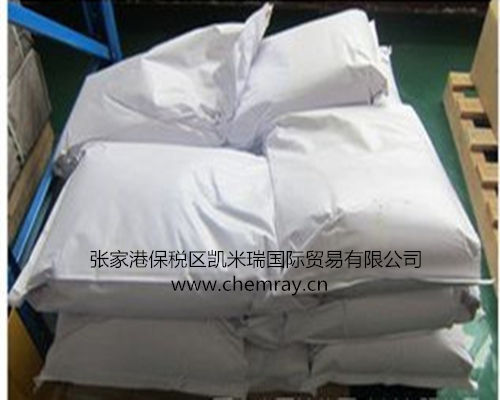三嗪酮

三嗪酮
产品信息
英文名称:4-Amino-6-(tert-butyl)-3-mercapto-1,2,4-triazin-5(4H)-one
化学名称: 4-氨基-6-叔丁基-3-巯基-1,2,4-三嗪-5(4H)-酮
CAS NO:33509-43-2
EINECS号:......
危险等级:.......
化学结构
产品规格:化学含量:≥95.0%
水份:<0.5%
理化性质
产品外观:白色至类白色粉末
熔 点:70-73℃
分子量: 200.26
分子式: C7H12N4OSH
其他事项产品包装:净重25kg/桶或编织袋包装。
储存条件:本产品应储存在于阴凉、干燥的地方避光密封保存、不能露天摆放。
保存期限:本产品在包装完整、未开封的情况下,自生产之日起保质12个月。
用途:制造除草剂--嗪草酮产品的中间体。
三嗪酮类化合物是一类具有潜在生物活性的杂环化合物,具有杀虫活性的吡蚜酮是三嗪酮类化合物的典型代表,具有高效、低毒、环境友好的特点。
三嗪酮类衍生物具有广泛的生物活性,它不仅在抗癌、抗溃疡、抗炎等方面具有显著的疗效,而且在杀虫、除草、植物生长调节和提高农作物产量等农业领域中表现出良好的活性。
三嗪酮类化合物的合成关键是中间体氨基三嗪酮。
在所有的三嗪酮类的化合物中,1,3,5-三嗪-2,4-二酮和1,2,4,-三嗪-5-酮具有除草活性,1,2,4-三嗪-3-酮具有杀虫活性。其中1,2,4,-三嗪-5-酮是一种重要的杂环类化合物,广泛应用于制药和农业生产中。
MATERIAL SAFETY DATA SHEET4-amino-6-(tert-butyl)-3-mercapto-1,2,4-triazin-5(4H)-one |
1. Company:
Zhangjiagang (FTZ) Chemray International Trading Co., Ltd.
Add.: Room 1515, Petrochemical Trading Building, Free Trade
Zone, Zhangjiagang, Jiangsu, China 215634
Tel.: +86 512 5830 8381
Fax.: +86 512 5830 8382
Trade name: 4-amino-6-(tert-butyl)-3-mercapto-1,2,4-triazin-5(4H)-one
Emergency phone number: +86 512 5830 8381
Composition of the product and info about the ingredients
Use: INTERMEDIATE
Chemical formulation: 4-amino-6-(tert-butyl)-3-mercapto-1,2,4-triazin-5(4H)-one
Content a.s | Classification | R-sentences | Active ingredient |
95% | Xn | 22 | Triazinone |
3. Potential Hazards
Very toxic to aquatic organisms; may cause long-term adverse effects in the aquatic environment.
First aid measures
Inhalation: move victim to fresh air. If needed, administer oxygen or apply artificial respiration. Obtain medical attention if necessary.
Eye contact: immediately flush with water for 15 minutes, occasionally lifting the upper and lower lids. If irritation persists, seek medical attention.
Contact with skin: wash immediately with plenty of water and soap. If necessary seek medical attention.
Swallowing: give victim 1 or 2 glasses water to drink. Seek medical advice before inducing vomiting. Never give food or drinks to an unconscious victim. In case of accident or if you feel unwell, seek medical advice (show the label where possible).
Fire fighting measures
Suitable extinguishing media: CO2, dry powder, foam or water spray.
Not suitable extinguishing media: high-pressure water jet.
Special protective equipment: wear an independent respirator.
Specific method: when possible, let the fire burn out because the amount of water can enlarge the contaminated surface. Cool containers / tanks with water.
Accidental release measures
Personal precaution measures: use suitable protective agents.
Environmental protection measures: do not allow entering drains or watercourses.
Cleaning, clearing measures: take up mechanically. Clean up affected area. Use an adequate container for disposal.
Exposure controls / Personal protection
Technical measures: provide adequate ventilation, especially in closed areas.
Hygienic measures: wash hands before each break and after work. Keep away from food, drinks and animal feeding stuff. Do not eat, drink or smoke during handling.
Personal protection:
Respiratory protection: use a respirator with a P1 filter.
Hand protection: protective gloves.
Eye protection: safety goggles.
Handling and storage
Handling: handle product in a well-ventilated area. Normal precautions for handling chemicals should be respected. Use personal protective agents. Keep away from heat or ignition sources.
Storage: store in a cool, dry, well-ventilated area, out of reach of children. Store in fireproof location. Keep package well closed. Do not store together with strong acids and alkali. Keep away from food, drinks and animal feeding stuff.
Physical and chemical properties
Appearance: granular
Colour: white – yellow
Odour: sulphur
pH: 5 – 7 @ 20°C
Melting point: 125.5 –126.5 °C
Self-ignition temperature: 350°C
Relative density: not applicable
Bulk specific density: 460 kg/m³
Solubility: dispersible
Stability and reactivity
Stability: stable under normal, dry storage conditions.
Conditions to avoid: formation of dust in closed areas.
Materials to avoid: acid and alkali conditions
Hazardous decomposition products: SO2 and NOx
Toxicological information
LD50 acute oral: > 2000 mg/kg (rat)
LD50 acute dermal: > 1000 mg/kg (rat)
LC50 inhalation (1h): > 160 g/m³ (rat)
Local effects:
Skin: non irritant
Eyes: non irritant
Ecotoxicological information
Toxicity to aquatic organisms and water fauna:
LD50 rainbow trout (96h): > 14.3 mg/l
LD50 bluegill sunfish (96h): 80 mg/l (metribuzin)
LC50 Daphnia (48h): 4.5 mg/l (metribuzin)
Toxicity to birds:
LD50 Bobwhite quail (8 days): 715 mg/kg
LD50 mallard duck (8 days): 4000 mg/kg (metribuzin)
Bio-accumulation
Log Pow 1.60
Disposal considerations
Remainders of spraying solution ought to be diluted 10 times and sprayed over the treated plot according to the descriptions of use. Do not pollute ponds, watercourses and canals with the product or the empty packaging. Never reuse the empty packaging for other materials. To avoid spraying solutions after treatments, calculate how much liquid is needed on the basis of the area that need to be treated and the amount of water needed for each hectare
The empty packaging need to be rinsed with water by means of a manual system (three successive times shaking with water) or by means of a cleaning system with water under pressure, placed on the spraying tank. The wash water needs to be poured in the spraying tank. The rinsed packaging must be brought to a specific collector.
Transport information
Not dangerous goods
UN Number : --
Regulatory information
R-sentences:
R50/53: Very toxic to aquatic organisms; may cause long-term adverse effects in the aquatic environment.
S-sentences:
S2: Keep out of reach of children.
S13: Keep away from food, drink and animal feeding stuffs.
S20/21: When using, do not eat, drink or smoke.
Other information
All information and instructions provided in this MSDS are based on the current state of scientific and technical knowledge at the date indicated on the present MSDS and are presented in good faith and believed to be correct. This information applies to the PRODUCT AS SUCH. In case of formulations or mixes, it is necessary to ascertain that a new danger will not appear. It is the responsibility of persons in receipt of this MSDS to ensure that the information contained herein is properly read and understood by all people who may use, handle, dispose or in any way come in contact with the product.



